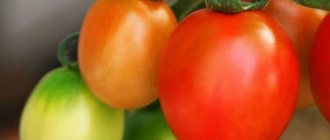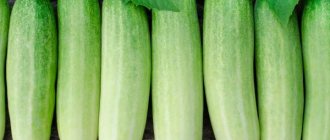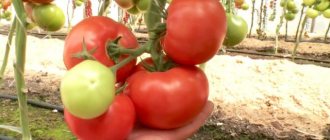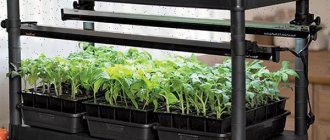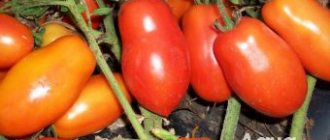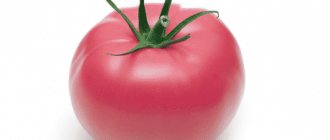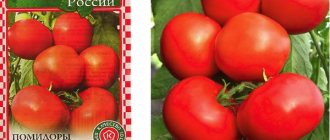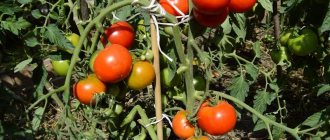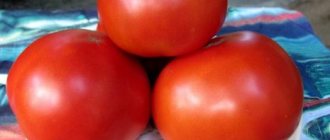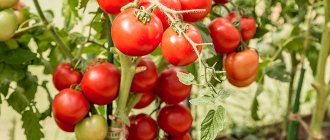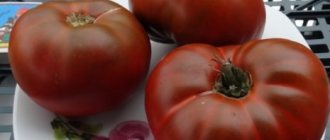Among the tomatoes suitable for planting for sale, the hybrid Amulet f1 occupies not the last place. It has gained its fans thanks to its taste and ease of care.
| Height | Landing location | Ripening time | Fruit color | Fruit size | Origin | Fruit shape |
| short | Greenhouse, Open ground | Mid-season | Reds | Average | Hybrid | Plum-shaped or oval |
Description of the Amulet tomato, fruit characteristics and pest control
The Amulet F1 tomato is a representative of a hybrid variety, distinguished by its excellent presentation, good transportability and excellent taste. This is an unpretentious variety that requires minimal care. Tomatoes are resistant to nightshade diseases, so they can be safely planted in garden beds.
What is an Amulet tomato?
Characteristics and description of the variety:
- Tomato Amulet is an early ripening variety, ripening in 110-120 days.
- Determinate bushes, on average, grow up to 70 cm. The leaves are medium-sized, rich green in color, and the foliage is medium.
- The variety is very productive, the fruits ripen together.
- Like all hybrid varieties, they have increased disease resistance.
- Ripe tomatoes on the bushes remain fresh for a long time and do not overripe.
- Those who grew the Amulet in their garden were satisfied with the result of their labors. It is also planted by people who have large farms.
Hybrid varieties of tomatoes are not suitable for seeds. To grow, you need to purchase them from the manufacturer each time.
Tomatoes of this variety are often popularly called Talisman. The amulet is easy to recognize among its fellows by its shape resembling an egg. They are not prone to cracking due to their thick and smooth skin. Ripe fruits have a rich red color. Tomatoes of this variety consist of 2-3 seed chambers.
The weight of each varies between 85 and 100 g. This is the optimal size for pickling whole fruits in jars.
How to grow tomatoes
Sowing seeds for seedlings begins 1.5-2 months before planting in the ground. The most suitable time is the end of March or beginning of April
At the time of transplanting the plant to a permanent place, the soil has time to warm up, which is important for growing tomatoes.
Tomatoes are a heat-loving crop. For their normal growth and development, during the day the air temperature should reach +20...+25 ºС, and at night drop no lower than +18 ºС. Tomatoes love ventilated areas and a light breeze.
Tomatoes need to be pruned in time to avoid the growth of abundant green mass. It interferes with fruit setting. In order not to confuse the stepson with a flower brush, you need to remember that it grows between the main stem of the plant and the leaf.
Since the bushes are not very tall, you can do without tying them up. The support is useful in bad weather or strong winds to prevent breakage of the fruit clusters.
Those who have often planted tomatoes and have experience in growing this crop are advised to choose places for planting where cucumbers, cabbage, herbs or zucchini previously grew. It is advisable that the chosen location be bright and protected from sunlight.
To prevent the soil from drying out quickly and to maintain moisture, the roots are covered with mulch. You can use leaves from different plants, as they turn into fertilizer over time. Frequent watering is harmful to the root system.
Excess moisture becomes a favorable environment for the development of fungal disease. During the period of fruit ripening, tomatoes are rarely watered.
In order to prevent fungal diseases, it is recommended to spray bushes with tomatoes with a soap solution or a solution of copper sulfate and lime (Bordeaux mixture).
Reviews about this variety of tomatoes are positive. Large companies producing pickles and canned tomatoes became interested in them. They note good transportability and the ability to collect fruits using combines.
Vegetable growers who like the combination of a wonderful sweet taste and amazing aroma of the fruit are also pleased with Amulet tomatoes. They are also satisfied with the compact size of the fruit, which easily fits into jars. In the review of the gardener who planted this variety for the first time, a mistake she made was noted: when forming the bushes, she left 2 stems, although it was quite possible to leave 4-5 pieces.
Amulet – variety of Tomato plant
Variety characteristics:
Properties of the Amulet variety:
Recommended region on the map:
Information about the admission of Tomato Amulet from the Register of the State Variety Commission of the Russian Federation
Application for admission No. 32348, registered 1999-02-25. The Tomato Amulet variety was included in the register of approved varieties in 2000. Approved for use in the regions: North Caucasus.
The originator of the Tomato Amulet variety is:
Other varieties of tomato plant
Search for variety by name
Variety selection
Question to the portal experts
If you haven't found the answer to a question, don't hesitate to ask an expert.
Have you already planted Tomato Amulet?
Tell us if you liked this variety? Will you plant it again?
Register or Login so you don't have to enter your Name and Email every time
Thanks for the comment! It will be published after checking by a moderator!
No comments yet, be the first!
A portal for those who love their dacha
Your question has been sent for moderation. Don't worry, we quickly check your questions and your question will be answered within 1 day.
We have noticed that you are already registered on our website. We recommend that you log in to view the question you created. If you don't remember your password, you can recover it.
You were not registered until today, so we have registered you. Your password has been sent to your specified mailbox.
Help our site develop!
Please read this message, it will not take up much of your time!
We so need your comments and questions to understand in which direction we should develop.
Don't forget to leave a comment if you found what you were looking for. And if you haven’t found it, use the “Ask an Expert” form in the site header. We will answer this question, and other visitors will be able to find the information that you could not find.
Sincerely, team of the portal Dacha-Dacha.ru
Your question has been sent for moderation. Don't worry, we quickly check your questions and your question will be answered within 1 day.
We have noticed that you are already registered on our website. We recommend that you log in to view the question you created. If you don't remember your password, you can recover it.
You were not registered until today, so we have registered you. Your password has been sent to your specified mailbox.
Description of the tomato variety Sharada, its characteristics and yield
Tomato Sharada is a pickling variety that belongs to one of the best examples of German selection and tolerates the climatic conditions of the northern regions well. Suitable for growing in open ground beds and for all types of greenhouses. Seed material is produced in St. Petersburg.
About the variety
- The ripening period is super early, less than 100 days pass from the emergence of seedlings to the first harvest.
- Bushes of the Sharada variety are characterized by determinant growth; they do not exceed 1 m.
- On average, bushes are 60–70 cm high, stable under the weight of the crop, do not need support or tying, and there is no need to pin bushes of this variety.
- The leaves are very small, which indicates the plants are highly drought-resistant.
- The variety is resistant to diseases.
The description of the fruits given by the originator indicates that they are plum-ovoid in shape, weighing 80–95 g, smooth, red in color, very dense, have a lot of pulp, and produce more than 7 kg of fruit per square meter. The skin is thin and dense. Tomatoes have few seeds, only 2 or 3 seed chambers. The fruits are suitable for all types of whole-fruit canning, including those in the state of milky-waxy ripeness. In late autumn they ripen well without loss of taste.
How to grow a Sharada tomato with your own hands?
Very early tomato allows you to apply growing technologies both through seedlings and in non-seedling culture. Sowing seeds for seedlings with subsequent planting in open ground is carried out in the second half of March. If you plan to plant in a film greenhouse, you can sow 1–2 decades earlier. Seedlings are picked at the age of one or two true leaves according to the 8x8 or 10x10 cm pattern. During the period of seedling growth, they are fed 2-3 times with humic fertilizers. Planting seedlings in open ground is carried out at the end of May or beginning of June. If there is a threat of return frosts, it is advisable to cover the bed with tomatoes with a low-density covering material.
To obtain a seedless crop, sowing is carried out in late April - early May in rows according to the 30x15 pattern. If the weather is cold, the crops should be covered with plastic wrap. When plants reach the age of 2-3 true leaves, thinning is carried out to achieve a 30x30 cm pattern, removing plants one at a time. The value of seedless culture is that the plants form a deep taproot, receiving more moisture and nutrients from the deeper layers of the soil.
Important! Tomatoes grown without seedlings should not be replanted. Determinate tomato variety Sharada is responsive to loosening and light hilling of bushes
As the plants mature, the soil is mulched with straw, sawdust, and mowed lawn grass. Before watering and subsequent loosening, the tomato is fertilized with complex mineral fertilizers. At the beginning of the growing season, high doses of nitrogen are given, in the middle of the growing season the proportion of phosphorus in the fertilizer is increased, and at the beginning of ripening, the proportion of potassium increases by 2–2.5 times. In addition to mineral fertilizers, it is advisable to fertilize tomatoes with chicken droppings or mullein infusion. Watering is carried out once every 5–7 days. Irrigation water should not be cold, otherwise the plants will experience stress.
The determinate tomato variety Sharada is responsive to loosening and light hilling of bushes. As the plants mature, the soil is mulched with straw, sawdust, and mowed lawn grass. Before watering and subsequent loosening, the tomato is fertilized with complex mineral fertilizers. At the beginning of the growing season, high doses of nitrogen are given, in the middle of the growing season the proportion of phosphorus in the fertilizer is increased, and at the beginning of ripening, the proportion of potassium increases by 2–2.5 times. In addition to mineral fertilizers, it is advisable to fertilize tomatoes with chicken droppings or mullein infusion. Watering is carried out once every 5–7 days. Irrigation water should not be cold, otherwise the plants will experience stress.
Valuable characteristics of the Sharada tomato: a friendly yield of a very early harvest, plant resistance to pests and diseases, high drought resistance, the ability to withstand cold spells without reducing yield, excellent pickling qualities. Reviews of this tomato are positive, even in the northern regions.
Characteristics of the variety
The amulet has gained one of the best positions over the past few years. It is chosen by gardeners for its excellent characteristics, which result in a large harvest of fruit. Tomatoes can be grown:
- in open ground;
- under film covers;
- in greenhouse conditions.
The variety is capable of producing an excellent harvest in almost all latitudes of the Russian Federation, excluding the regions of the Far North.
Tomato Amulet has the following properties:
- From the appearance of sprouts to the ripening of fruits, 110 to 120 days pass.
- The bushes are small, growing from 40 to 60 cm in height. In greenhouse conditions, specimens 80-90 cm in height are found.
- One bush can simultaneously ripen from 19 to 22 medium-sized tomatoes.
- The fruits are elongated in shape, similar to plums, and during the period of technical maturity they have a greenish tint, which at the moment of ripening changes to golden yellow.
- Fruits with a smooth surface have juicy pulp.
- The slightly tough skin allows the fruits to maintain a presentable appearance for a long time.
- It is thanks to this quality that tomatoes can be transported over long distances.
- Fresh tomatoes of the Obereg variety will give the salad a unique taste. The fruits can be canned.
Advice! In cold and rainy summers, tomatoes take a long time to turn yellow. To make this procedure go faster, gardeners with extensive experience recommend tearing off the lower leaves on the bush. You can also remove ovaries that do not have time to ripen in a timely manner.
Characteristics of the tomato variety Burkovsky early
The Burkovsky early tomato is characterized by unpretentiousness to growing conditions and high resistance to most diseases, including late blight and tobacco mosaic virus. Able to set fruit even in unfavorable weather.
The taste of the fruit is assessed as good or excellent, the aroma is strong. The taste is dominated by sweetness, but not without the sourness characteristic of many early tomatoes. The main purpose of the harvest is salad, but excess harvest can be processed into any product. The variety is suitable for both pickling and drying.
Burkovsky early has a high yield; with proper care, up to 3 kg of tomatoes can be harvested from one bush, which, when planted tightly, allows you to get up to 15 kg of produce per square meter. Tomatoes tolerate transportation and long-term storage well, which arouses the interest of farmers who grow vegetables for sale.
The Burkovsky early tomato fruits look good: smooth, without flaws, quite marketable
Thus, the most important advantages of the Burkovsky early tomato are complex resistance to diseases and vagaries of weather, unpretentiousness, and ease of care. Productivity is also good. The quality of its fruits is apparently not the best: among early-ripening tomatoes you can currently find many varieties with an exquisite taste. However, those that would combine only positive qualities probably do not yet exist.
Variety: First-grader
- Strawberries were sectioned at NIISS in 1990 by crossing Fairy and Torpedo.
- The bushes are small, semi-spreading. They have emerald, shiny large leaves.
- The berries are large, at the first harvest - 38.1 g, at subsequent harvests - 10.1 g.
- During the first harvest, the berries are barrel-shaped, and during subsequent harvests, they are blunt-conical.
- Composition of berries: dry soluble substances 10.05%, acid 1.0%, sugar 6.8%, ascorbic acid 35.5 mg%. Medium ripening variety.
- Up to 10.2 tons of fruits are collected from 1 hectare.
Advantages:
- High frost resistance.
- Large berries.
Flaws:
Not resistant to leucorrhoea (powdery mildew) and white spot.
The mid-season strawberry variety Amulet is valued for its stable yield, attractive appearance and excellent taste of the berries. The bush is medium-sized, compact (suitable for dense plantings), with large ribbed leaves and a small number of tendrils. Peduncles at the level of leaves, strong, multi-flowered. The berries are medium and large, beautiful, regular, elongated in shape, rich red in color with shine. The pulp is red, dense, juicy, with a classic sweet and sour taste with a bright strawberry aroma. The harvest yield is friendly, the yield is high. The berries are universal to eat: they are delicious fresh, perfect for any processing (including drying and freezing), they tolerate transportation well, do not wrinkle or leak. Strawberry Amulet has good immunity, high winter hardiness and drought resistance, is resistant to strawberry mites, is easy to care for - a reliable variety that will not leave you without a harvest!
Description and characteristics of tomato variety Fitous
A mid-early variety, the Fitous tomato, is intended for cultivation in greenhouses and open ground. It is popular with many summer residents for its positive qualities. Released in 1997.
What is the species
Tomatoes of this variety are quite popular. The description shows that they are unpretentious and resistant to diseases.
- Bush: determinate.
- Height: 50 cm.
- Stem: powerful.
- Inflorescence: simple.
- Number of tomatoes in a brush: from 4 to 6 pcs.
- Ripening time: 95-110 days (from seed germination).
- Color: red.
- Shape: oval.
- Weight: 50-70 g.
- Number of cameras: 2-3 pcs.
- Density: high.
- Peel: not hard, but does not allow cracking.
- Taste: excellent.
- Transportability: excellent.
- Shelf life: long time.
Planting and care
"Fitous" tomatoes grown by seedlings. They begin to sow seeds at the end of March or beginning of April (depending on the region). The seed planting depth is 1 cm.
Does not require pinching or gartering.
Planted in the ground at a distance of 50 cm between plants. Thus, no more than 3 bushes are placed per 1m2. The soil should be well moist and slightly acidic. You can add superphosphate (10 grams per hole).
It is best to water tomatoes after sunset, and the water should be warm. To obtain a high yield, you should feed the tomatoes. The first time, 2 weeks after landing in a permanent place. The second time before flowering, the third time before the active ripening of fruits.
Disease susceptibility
"Fitous", tomatoes that are late blight resistant. In addition, it is not susceptible to other common diseases.
In case of pest attack, it should be immediately treated with special preparations. But only if the plant does not bear fruit. During the period of fruit ripening, it is better to treat with folk remedies, this will prevent chemical elements from getting on the vegetables.
Harvest volume and application
The productivity of the Fitous variety is high. With proper agricultural technology and compliance with all necessary requirements, a small plant grows, strewn with vegetables.
Retains excellent taste regardless of the cooking method.
The application is very diverse, depending on who has the imagination. All favorite winter preparations are prepared with their participation. The taste of tomatoes is excellent; with whole-fruit canning, the appearance and integrity of the structure are preserved. Perfect for preparing salads and eating fresh.
Positive and negative aspects of the species
Many gardeners pay attention to the characteristics of good and bad in a plant. Making your final choice on this basis
- High yield.
- Disease resistance.
- Unpretentiousness and undemandingness.
- The fruits do not crack, last a long time and tolerate transportation well, maintaining their presentation.
- Does not require plant formation.
No disadvantages of the variety have been identified.
Opinions of summer residents regarding the Fitous tomato
Reviews from summer residents will help a novice gardener understand how to grow tomatoes, whether they should be fertilized or not, whether formation is necessary and much other useful information.
- Lyudmila Ponomoreva. They live in Siberia. He writes: “I grow it in open ground. Even the smallest tomatoes ripen. Excellent for preservation. Very good variety."
- Alexander. I planted “Fitous” on my plot. Several bushes produced a variety of other tomatoes. Definitely going to grow more.
- Margarita. He has been growing tomatoes on the plot for 3 years. Satisfied with the characteristics of the variety. The yield is very high, it formed into 2 trunks. The tomatoes turned out larger than in the description. After forming 6 brushes, the growth point was removed. I was satisfied with everything. The taste of pickled tomatoes is amazing.
Many summer residents choose this variety because it is resistant to late blight, is unpretentious and produces a lot of yield. Thanks to these qualities, it became a favorite for many of them.
Tomato seeds Amulet, 0.5kg
| call me back |
| Terms of payment and delivery |
| Return and exchange conditions |
Return of goods by agreement within 14 days
Returns are possible within 14 days after receipt (for goods of good quality).
Return delivery of goods is carried out by agreement.
Taking into account the peculiarities of remote sales and delivery, we undertake to return money or exchange goods if the client is not satisfied with it, subject to the conditions. If you are not satisfied with the products you purchased, the product can be returned or exchanged. This procedure will take place without complications if you follow simple rules: – the claim was submitted no later than 14 days from the date the buyer received the goods; – the goods are returned in the same way as they were received, in the original packaging with accompanying documents, without damage; – only the cost of the goods is reimbursed (without shipping costs, commissions, etc.). We value our client, so we are always ready to consider such situations and strive to make the most convenient decisions for the buyer.
Description
We suggest you buy tomato seeds in the “7 sotok” store. Tomato Amulet - suitable for combine harvesting!
Amulet tomato seeds - intended for fresh consumption, whole-fruit canning and processing into tomato products. Can be recommended for combine harvesting. Mid-season variety. The growing season from germination to ripeness is 110-120 days. The plant is determinate, semi-spreading, medium-branched, heavily leafy. The height of the main stem is 68 cm, heavily leafy. The inflorescence is simple, with 5-6 fruits. The fruits are smooth, cylindrical, dark red in color, dense, weighing 75-90g, excellent taste. Suitable for long distance transportation. The variety is resistant to tobacco mosaic virus and Alternaria.
Agricultural technology.
If you grow tomatoes, then you need to know that these vegetables are heat-loving crops. You can sow tomato seeds in the ground or transplant seedlings only when the threat of night frosts has completely passed and the soil has warmed up sufficiently. Early crops should be covered. With the seedling method of growing, seedlings are transplanted into the ground at the age of 55 - 70 days. It is best to grow seeds for seedlings in special pots, feeding them with fertilizers. It is also worth feeding Amulet tomatoes throughout the growing season. Tomatoes require regular watering. They do not like windy places.
Sowing and harvesting tomatoes Amulet
All descriptions of agricultural technology are advisory in nature and the results obtained during cultivation depend on the cultivation technology and agroclimatic conditions.
Assortment of tomato seeds in large packaging
| Early ripening varieties of tomatoes | |
|
|
| Mid-early tomato varieties | |
|
|
| Mid-season tomato varieties | |
|
|
Pests of hanging tomatoes of the “Talisman” variety
When growing tomatoes of this variety in open ground, it is very difficult to avoid pests and diseases.
What diseases can tomatoes have:
mosaic - spots of a different color appear on the leaves: lighter or darker. Over time, the leaves curl and grooves appear on them. In this state, the plant suffers, which affects the yield. The fruits gradually turn yellow and dry out, the plant lacks nutrients, and it begins to die. Control measures: removal of affected bushes and complete destruction; Late blight is one of the most terrible diseases of tomatoes of any kind. How it manifests itself: dark areas appear on the fruit, which, upon closer examination, are located under the skin. The leaves also suffer: they become covered with a light coating. Treatment of plants with any fungicides is required at the initial stage of the disease. For example, drugs containing copper “Ridomil”, “Acrobat”, “Thanos”. When processing bushes, you need to calculate the period of decomposition of the substance, otherwise you can be poisoned by the processed fruits. In order not to overload the plants with chemicals, you can use old proven methods: treat the plants with 1% Bordeaux mixture 2 weeks before harvest, in combination with copper oxychloride and cuprosate, take no more than 30 g per 10 liters of water; “Brown spot” disease - a brownish coating appears on the lower part of the leaves. One of the main methods is prevention; you need to remove all dry and damaged plant debris; cracking - this variety is practically not susceptible to cracking, but this can happen with excess moisture. Therefore, when caring for plants, it is important to observe moderation in watering and loosen the soil in time (when growing on the site), and in flowerpots - to ensure good drainage and to grow tomatoes in light soils.
Let's look at them and find out how to deal with them:
- The most insidious pest of tomatoes of any variety is the mole cricket. It digs deep tunnels underground, gnawing at the base of the stems. Because of this, plants quickly die. To get rid of a mole cricket, you need to try hard. One of the effective methods is soil cultivation with “Thunder”. It is advisable to begin pest control before planting. A teaspoon of the substance is placed in the holes that the mole cricket has dug, going 5 cm deep, then the soil is well watered. The granules get wet and this smell attracts pests that eat the bait. After a couple of days, all the mole crickets die.
- Wireworm is another garden pest that damages the root system of tomatoes by getting inside the plants. The fight against this pest is difficult because you need to dig up the entire area and select all the larvae. But the method works temporarily until new individuals migrate from the neighboring area. This pest is afraid of lime, so after digging it is necessary to add lime to the soil and put a handful of lime in each hole when planting garden crops.
- The Colorado potato beetle can harm plants if there is too much of it in the area. Striped bugs crawl under the lower leaves, laying eggs. Young individuals, developing, gradually gnaw leaves, approaching the trunks. Control measures: manual collection of pests and destruction on neutral territory, away from the site.
- Slugs are another pest of tomatoes. When grown in flowerpots on the site, they can reach tomatoes. They love a humid environment, waterlogged soils and if the tomato crops in the open ground are thickened. If you want to grow hanging tomatoes on your plot, you must maintain a distance of at least 60 cm when planting.
Gardeners use the main secret of preventing many diseases, “Amulet”. It consists of removing dry leaves and inspecting the formed fruits. If there are spots on the fruits, and before this changes could be noticed on the leaves, this may indicate late blight. The stem suffers from this and becomes brown. The root system changes color. If the plant fits these descriptions, there is no way to save it.
As for a disease such as dry spotting, it is extremely rare for the “Obereg” tomato variety. But once the disease appears, it spreads quickly. This means that the gardener’s reaction should be immediate. To eliminate the disease, high-quality and proven fungicides are used, which will quickly destroy the cause of dry rot in the form of a pathogenic microorganism. Bacterial spotting, which occurs in Amulet, is eliminated in the same way.
READ MORE: Tomato Grigorashik f1: cultivation and description of the variety with photos
How to choose the right strawberry variety for Siberia
To choose the right variety for cultivation in Siberia, you should consider the following characteristics:
- resistance to frost;
ability to quickly recover after leaf fall;
high immunity to diseases and insect pests characteristic of the culture;
- resistance to external, mechanical damage, which is required for transporting fruits over long distances.
Growing and caring for strawberries in Siberia - video
These are the main criteria that should form the basis of the choice. It is difficult to find a variety that combines all of the listed properties. However, there are excellent strawberries with excellent performance for the Siberian climate.
general characteristics
The main task that was set when breeding the hybrid Verochka f1 was to improve the taste characteristics.
Tomatoes are grown both in open ground and in closed greenhouses. Zoned in all areas of Russia for different climatic conditions..
Tomatoes are early ripening - they ripen 90-95 days after planting the seeds, in hot climate regions - after 75 days. They are distinguished by friendly shoots and uniform fruiting.
Description of the plant:
- low-growing bushes (determinant type): up to 0.5-0.6 m high - in an open bed; up to 1.0 m - in a greenhouse;
- compactly built bushes with good shoot formation and foliage;
- classical scheme of development of foliage and inflorescences, semi-compound buds, laid above 6-7 leaves with subsequent frequency every 2, leaves petiolate, green color;
- The length of the brush is about 20 cm, the average number of fruits on the shoot is up to 5-6.
The shape of the tomatoes is round, diameter 6-7 cm, the peel is dense but thin, with small edges at the stalk, the surface is glossy, the color is red. The average weight of vegetables is 100-120 g.
There are 4-5 seed chambers inside, the pulp is juicy, the structure is fleshy;
Productivity
Yield indicators:
- when grown indoors in a greenhouse - up to 15 kg/m²;
- when planting in open ground - up to 20 kg/m²;
- the average amount of harvest per bush is up to 4-5 kg.
Taste qualities
Verochka f1 tomatoes have a sweetish taste with a subtle sourness. They are suitable for fresh consumption, cooking, canning whole fruits, making juices and other culinary processing.
Growing indoor tomato
The last harvest has long been harvested in the gardens. What a pity that we won’t see new fresh greens on the table until next summer. However, not everything is so sad. There are a number of crops that can be successfully grown indoors at any time of the year. And tomatoes are no exception!
The good news is that indoor varieties of tomatoes are not only a source of wonderful small fruits, but also an excellent decorative element for the kitchen. Agree, in winter neat miniature bushes dotted with small red fruits will always please the eye. I usually sow indoor tomato seeds in two periods: in July-August and November-December.
Among the varieties I prefer the unpretentious ones: Room Charm, Micron NK and Phytophthora-resistant.
Micron NK, in my opinion, is the most unique and miniature variety. The height of the plants is only 10-15 cm. It is super resistant to cold and does not need additional lighting. But it always rewards its owner with an incredibly large number of bright yellow fruits.
Trouble period
For growing indoor tomatoes, a pot with a diameter of 15-20 cm or a rectangular container for several bushes is suitable.
Before sowing, I always moisten the seeds. I place them in gauze bags and place them in a plate, the bottom of which is filled with warm water (the liquid should not cover the seeds!). After they have stood for a day, I disinfect them in a 1% solution of potassium permanganate for 20 minutes. I prepare the soil mixture for planting indoor tomatoes as follows: 10% humus, 80% garden soil, 10% sand; I pour boiling water over it. I sow the seeds to a depth of 0.5-0.7 cm, lightly sprinkled with soil, at a distance of 1.5-2 cm from each other. I water young seedlings very carefully so as not to wash away or compact the soil. After the formation of 2-3 true leaves, I plant the seedlings in 6x6x6 cm pots or large containers for permanent cultivation. Every week I feed the tomatoes with an EM extract prepared from the Baikal EM-1 preparation (100-150 g of solution for each plant). I continue this operation until the end of the plant growing season.
As a rule, indoor tomatoes are self-pollinating. But sometimes I have to help them by slightly shaking the flower brushes. After which it is better to spray the plants with water with the addition of a few drops of iodine - this increases the number of ovaries.
Light to the rescue!
In the evening and on cloudy days, seedlings may require additional artificial lighting. To do this, I use energy-saving fluorescent lamps with a power of 10 W, placing them at a height of 1-5 cm from the tops of the plants. To prevent the seedlings from bending during growth, I turn the pot every 1-2 days. However, I don’t do this during the flowering phase and after it.
. And no stress
I will definitely take care of the plants. I pinch the top of the main shoot after 4-5 clusters have formed. As soon as the fruits are ripe, I cut off the main shoot, leaving a replacement shoot. This allows you to harvest from the same plant for 3-4 years. Although the easiest way is to root the removed stepsons in the spring and get new young plants.
In weak-growing determinate indoor varieties (and these are the majority), only weak, thickening stepsons need to be removed. However, if desired, to increase the mass of fruits, you can leave, in addition to the main stem, the two most developed stepsons, removing all the others. Miniature varieties, for example, Bonsai, Mikron NK, Green Petal, do not need pinching at all.
Bow at the enemy
In late spring and summer, indoor tomatoes may be attacked by whiteflies. But it doesn't matter. Insects do not like onion peel infusion. Therefore, a couple of sprays are enough - and the whitefly will no longer appear.
Selection of capacity
Use any containers with a height of no more than 7 cm. Good results are achieved when grown in seedling boxes, peat tablets, cassettes and peat pots. The boxes are filled one third with drainage made from broken bricks or a mixture of peat and leaf soil.
Sowing in boxes
At the beginning of winter, the seeds are sown in shallow boxes measuring 50x30x10 cm with drainage from peat and leaf soil. Sod soil mixed with sand in a ratio of 3:1 is poured on top. spread the seeds, pressing them firmly onto a flat surface of the soil. Pour a 1 cm layer of sand. Then cover it with paper, on top of which crushed peat is laid.
The boxes are taken outside and left under the snow. At the end of February or March they are placed in a greenhouse or room. The peat crumbs are removed, the paper is moistened and covered with glass. After three weeks, shoots appear.
Instructions for sowing in containers - from the personal experience of gardeners:
- Fill the boxes with a soil mixture consisting of equal parts of turf, leaf soil and sand.
- Planting dates are December–January.
- Keep the boxes with crops at room temperature for a week, then take them outside and cover with a 5 cm layer of snow.
- At the end of February–beginning of March, place the containers in a room at 26° C.
- After the snow melts and the soil is ventilated, cover the boxes with glass.
Planted seedlings are grown in diffused light, avoiding direct sunlight.
Soil moisture is maintained by systematic spraying.
Seedlings appear on 8–10 days. Germination rate is 87%.
Growing strawberries from seeds in peat tablets
Expensive seeds of large-fruited varieties are packaged in bags of 5–10 pieces. It is not always possible to grow viable seedlings in a seedling box. Therefore, it is recommended to use peat tablets, since it is the easiest way to grow strawberries from seeds at home.
In addition to peat, the tablet substrate contains growth stimulants and essential micro- and macroelements.
Instructions for sowing in peat tablets
Before planting, the seeds are germinated - laid out between two layers of damp cloth, placed in a container with ventilation holes and kept for 3 days at 18° C. Then placed in the refrigerator for 2 weeks on a vegetable shelf. After stratification, the container is placed in a warm, bright place until the seeds germinate. Maintain moderate humidity at all times and ventilate the planting material.
How to sow strawberry seeds for seedlings:
- Peat tablets are placed in a container, filled with a pale lilac solution of potassium permanganate and left for 15–20 minutes.
- The tablets are lightly squeezed to remove excess liquid and placed in a container.
- The container must be equipped with holes for ventilation.
- The sprouted seeds are placed in the recesses of the tablets.
- The container is covered with glass or film and placed on the windowsill.
- The substrate is regularly moistened, since dry peat, when compressed, can injure the seedlings.
- The mini-greenhouse is ventilated daily.
Seedlings along with tablets are planted in pots or boxes.
Varieties and diseases of ampelous tomatoes
Although climbing tomatoes hardly get sick, in open ground under unfavorable conditions they are affected by some ailments. These are late blight, black leg, brown and gray rot. If it rains frequently or you overdo it with watering, the hanging fruits may crack. Among the pests, the spider mite is partial to them.
To avoid troubles, agricultural technicians recommend adding Trichodermin to the soil when planting according to the instructions.
Although all varieties of hanging tomatoes are of excellent quality, we will name several options for open and closed ground.
Red Abundance F-1
An early ripening variety, which is intended for indoors and outdoors. It does not require pinching; its vines reach a length of 60 centimeters. The brushes are covered with small red fruits. Resistant to diseases and pests. Fruitful.
Garden pearl
These are pink round cherry tomatoes weighing up to 20 grams. It is preferable to grow tomatoes at home in a small pot, since the bush is not tall - up to 40 centimeters. It does not require pinching and is productive.
One of the old and proven varieties of hanging tomatoes. It is cultivated both on the windowsill and in open ground. In the second case, it produces egg-shaped fruits weighing up to 80 grams.
